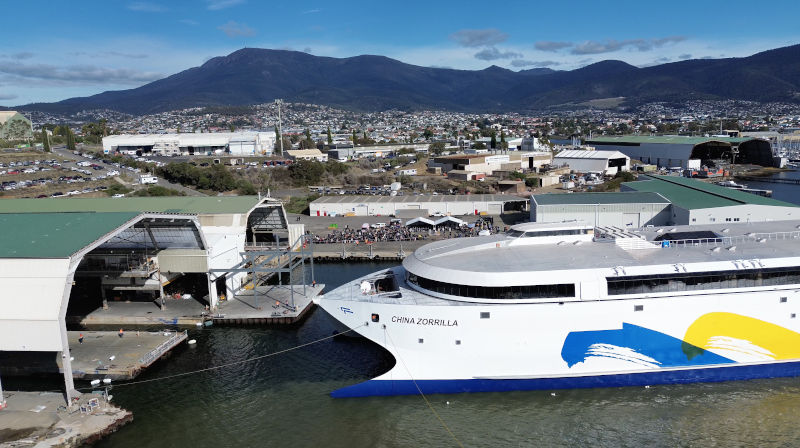'This ship changes the game': World’s largest all-electric ferry launches in Tasmania
May 6, 2025
The world’s largest 100% battery electric ship has been officially launched at a shipyard in Hobart and is almost ready for service in South American waters, where it will ferry up to 2100 passengers and 225 vehicles between Argentina and Uruguay.
The 130-metre, zero-emissions Hull 096 was constructed by Tasmanian ship builder, Incat, for South American ferry operator Buquebus.
The vessel, originally intended to be fuelled by gas, will be equipped with more than 250 tonnes of batteries and with an energy storage capacity of more than 40 megawatt-hours – four times larger than any previous maritime installation in the world.
The energy storage system is connected to eight electric driven waterjets that are being supplied by Finnish energy tech giant Wärtsilä.
With the vessel’s construction complete, the focus will now turn to finishing off its interior, which includes a 2300 square metre retail deck – the largest shopping space on any ferry in the world.
Incat says the ship’s final fit-out, battery installation, and energy system integration will take place ahead of sea trials later this year on the River Derwent in Tasmania.
Incat chair Robert Clifford said on 2 May that the launch of the huge craft marked an historic day, both for the company and for the future of maritime transport.
“We’ve been building world-leading vessels here in Tasmania for more than four decades, and Hull 096 is the most ambitious, most complex, and most important project we’ve ever delivered,” he said in a statement. “This ship changes the game.”
For Buquebus, the Hull 096 marks the ninth vessel Incat has built for the ferry operator, but the first that is zero emissions.
“When we were evaluating this new vessel, Robert Clifford told me, ‘The next ship I deliver to you will be 100% electric’,” said Buquebus president Juan Carlos López Mena.
“I replied, ‘Then the next one must be the one we’re commissioning today’. And with great courage, he said, ‘Together, we’re going to make history'.
“That’s how we began reconfiguring the China Zorrilla — originally planned to run on LNG — into a fully electric vessel. It’s a true milestone achieved between private companies, driven by our commitment to sustainability and our ongoing pursuit of service excellence.”
Incat claims the Hull 096 is not only the largest electric ship in the world, but also the largest electric vehicle of its kind ever built – and one of the most significant single export items in Australia’s manufacturing history.
“This ship puts Tasmania and Australia firmly on the world stage,” Clifford says. “We’re incredibly proud of what our team has achieved – and this is only the beginning.”
“We’re not just building a ship – we’re building the future,” said Incat chief executive Stephen Casey.
“Hull 096 proves that large-scale, low-emission transport solutions are not only possible, they are ready now. This is a proud day for Tasmania and for Australian manufacturing.”
Republished from THE DRIVEN, May 02 2025
